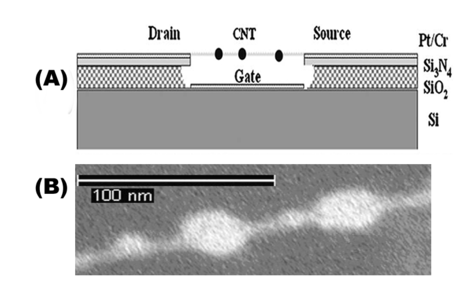High Frequency Abacus Nanotube Resonator
APPLICATIONS OF TECHNOLOGY:Filter or amplifier for microwave frequency and RF electronics, e.g. cell phones, personal music devices Mass sensor
ADVANTAGES:
- Frequencies over 4 GHz - Operates at ambient temperatures and pressures without significant loss of resonance quality - Individually tunable, post-production - Capable of mass detection with molecular resolution (10-18g)
ABSTRACT:
Various bottom-up and top-down fabrication processes have been used to create resonating NEMS devices but none have achieved ultrahigh frequency (>1 GHz) operation at room temperature in atmospheric pressure while maintaining adequate resonance quality. Alex Zettl and Haibing Peng of Berkeley Lab are the first to develop such a resonator, which has promising commercial applications in microwave and radio frequency electronic devices and could be used as a ultra-high sensitivity mass sensor.
The Berkeley Lab resonator consists of carbon nanotubes (CNTs) grown across trenches etched in silicon chips with the ends of the nanotubes connected to source and drain electrodes. Gate electrodes deposited in the bottom of the trenches allow for capacitive coupling to the nanotube. The invention employs a new combination of drive and detection methods that enables unprecedented measurement of both oscillation amplitude and phase. The resonator can be tuned after production by moving bead clamps along the nanotube using a novel mass transport method, also developed in the Zettl lab, much like a guitar string is tuned using finger pressure.
Scaling down the CNT-based resonator and selecting suitable coating materials may achieve resonance frequencies well over 10 GHz. Other materials such as nanowires and nanorods may be substituted for the carbon nanotubes.
Attached files:

Inventor(s): Alex Zettl, Haibing Peng
Type of Offer: Licensing
« More Nanotech Patents
